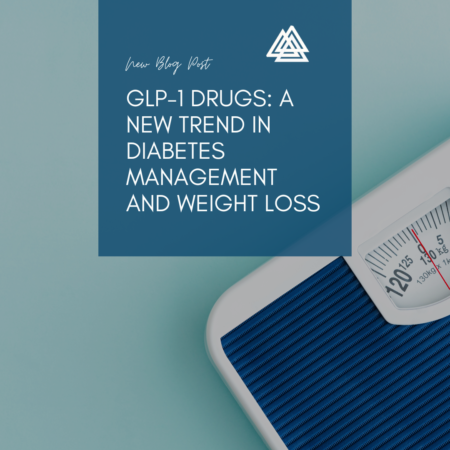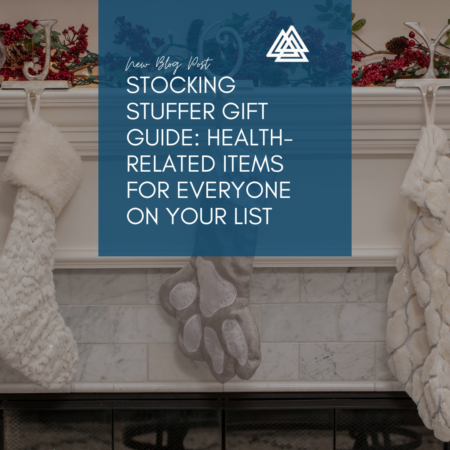Prism Post
 In recent years, GLP-1 (glucagon-like peptide-1) receptor agonists have emerged as a groundbreaking class of medications, revolutionizing the management of type 2 diabetes and capturing attention in the realm of weight loss. With their ability to enhance blood sugar control, promote weight loss, and even improve cardiovascular health, GLP-1 drugs are gaining popularity among healthcare providers and patients alike. In this blog post, we’ll explore what GLP-1 drugs are, how they work, their benefits, and their growing trend in the medical community.
In recent years, GLP-1 (glucagon-like peptide-1) receptor agonists have emerged as a groundbreaking class of medications, revolutionizing the management of type 2 diabetes and capturing attention in the realm of weight loss. With their ability to enhance blood sugar control, promote weight loss, and even improve cardiovascular health, GLP-1 drugs are gaining popularity among healthcare providers and patients alike. In this blog post, we’ll explore what GLP-1 drugs are, how they work, their benefits, and their growing trend in the medical community.
What Are GLP-1 Drugs?
GLP-1 is a hormone produced in the intestines that plays a significant role in glucose metabolism. It is released in response to food intake and has several important functions, including:
- Stimulating Insulin Secretion: GLP-1 enhances the secretion of insulin from the pancreas in response to elevated blood sugar levels.
- Inhibiting Glucagon Release: This hormone suppresses the release of glucagon, which is responsible for raising blood sugar levels.
- Slowing Gastric Emptying: GLP-1 slows the rate at which food leaves the stomach, contributing to a feeling of fullness and reducing appetite.
GLP-1 receptor agonists are synthetic versions of this hormone, designed to mimic its effects and provide therapeutic benefits. Some commonly prescribed GLP-1 drugs include:
- Liraglutide (Victoza, Saxenda)
- Semaglutide (Ozempic, Wegovy)
- Dulaglutide (Trulicity)
- Exenatide (Byetta, Bydureon)
How Do GLP-1 Drugs Work?
GLP-1 drugs work by activating the GLP-1 receptors in the body, which leads to several beneficial effects:
- Improved Blood Sugar Control: By stimulating insulin secretion and inhibiting glucagon release, GLP-1 drugs help lower blood sugar levels, making them effective in managing type 2 diabetes.
- Weight Loss: One of the most exciting aspects of GLP-1 drugs is their ability to promote weight loss. By slowing gastric emptying and reducing appetite, these medications help individuals consume fewer calories, leading to weight reduction.
- Cardiovascular Benefits: Studies have shown that GLP-1 drugs may provide cardiovascular protection, reducing the risk of heart attacks and strokes in individuals with type 2 diabetes.
- Potential Neuroprotective Effects: Emerging research suggests that GLP-1 may have neuroprotective properties, which could offer benefits for brain health and potentially reduce the risk of neurodegenerative diseases.
The Growing Trend of GLP-1 Drugs
The popularity of GLP-1 drugs is on the rise for several reasons:
- Effectiveness: Clinical trials have consistently demonstrated the effectiveness of GLP-1 drugs in improving glycemic control and facilitating weight loss. As a result, healthcare providers are increasingly recommending these medications as part of a comprehensive treatment plan for type 2 diabetes and obesity.
- Convenience: Many GLP-1 drugs are available as once-weekly injections, making them convenient for patients who prefer not to take daily medications. This convenience can improve adherence to treatment plans.
- Weight Loss Appeal: With obesity rates continuing to rise, there is a growing interest in weight management solutions. GLP-1 drugs, particularly those approved for weight loss (such as Wegovy), have garnered significant attention and have become a popular option for individuals seeking effective weight management strategies.
- Media Attention: Recent media coverage highlighting the success of celebrities and public figures using GLP-1 drugs for weight loss has further fueled interest in these medications. The narrative surrounding their effectiveness has sparked conversations about their potential beyond diabetes management.
Considerations and Side Effects
While GLP-1 drugs offer numerous benefits, they are not suitable for everyone. Potential side effects can include:
- Gastrointestinal Issues: Common side effects include nausea, vomiting, diarrhea, and constipation, particularly when starting the medication.
- Pancreatitis Risk: There is a potential risk of pancreatitis associated with GLP-1 drugs, so individuals with a history of pancreatitis should use caution.
- Thyroid Tumors: Some studies have raised concerns about the potential risk of thyroid tumors in rodents; however, the relevance to humans is still being studied.
It’s essential for individuals considering GLP-1 drugs to consult their healthcare provider to discuss potential benefits and risks tailored to their specific health needs.
Conclusion
GLP-1 drugs represent an exciting advancement in the management of type 2 diabetes and weight loss. With their ability to improve blood sugar control, facilitate weight loss, and provide cardiovascular benefits, these medications are becoming increasingly popular among healthcare providers and patients. As the trend continues to grow, it’s crucial to approach GLP-1 drugs with an understanding of their benefits, potential side effects, and the importance of a comprehensive treatment plan.
If you’re considering GLP-1 therapy, consult with your healthcare provider to determine if it’s the right option for you on your journey toward better health and well-being.
 The holiday season is a time for giving, and what better way to show your loved ones you care than by gifting health-related items? Whether you’re shopping for family members, friends, or colleagues, thoughtful gifts that promote wellness can make a positive impact on their lives. In this holiday gift guide, we’ll explore a variety of health-related gifts that cater to different interests and needs.
The holiday season is a time for giving, and what better way to show your loved ones you care than by gifting health-related items? Whether you’re shopping for family members, friends, or colleagues, thoughtful gifts that promote wellness can make a positive impact on their lives. In this holiday gift guide, we’ll explore a variety of health-related gifts that cater to different interests and needs.
- Fitness and Activity Gifts
Fitness Trackers
Help your loved ones stay active and motivated with a fitness tracker. These devices monitor steps, heart rate, sleep patterns, and more, encouraging a healthier lifestyle.
Resistance Bands
Perfect for home workouts, resistance bands are versatile, easy to store, and suitable for all fitness levels. They can enhance strength training and flexibility exercises.
Subscription to a Fitness App
Gift a subscription to a fitness app that offers guided workouts, yoga classes, or meditation sessions. This allows the recipient to choose activities that fit their lifestyle.
- Nutrition and Healthy Eating
Meal Prep Containers
Encourage healthy eating with stylish meal prep containers. These can help with portion control and organization, making it easier to maintain a balanced diet.
Healthy Cookbooks
Select a cookbook focused on healthy recipes, such as plant-based meals, gluten-free options, or low-carb dishes. This can inspire your loved ones to explore new cooking techniques and ingredients.
Gourmet Health Foods
Consider gifting a selection of gourmet health foods, such as organic snacks, protein bars, or superfoods. These treats can be a delicious addition to anyone’s pantry.
- Mental Well-Being
Meditation Cushion
For someone interested in mindfulness and meditation, a comfortable meditation cushion can enhance their practice and encourage relaxation.
Aromatherapy Diffuser
Aromatherapy diffusers can create a calming atmosphere at home. Pair it with essential oils like lavender or eucalyptus for a thoughtful gift that promotes relaxation and stress relief.
Journals for Mental Wellness
Gift a guided journal that encourages reflection, gratitude, or goal-setting. Writing can be a therapeutic practice that helps reduce stress and improve mental health.
- Personal Care and Relaxation
Massage Tools
Help your loved ones unwind with massage tools, such as a foam roller, massage balls, or handheld massagers. These can alleviate tension and promote relaxation after a long day.
Bath Products
Consider pampering gifts like bath bombs, salts, or soothing body scrubs. These items can create a spa-like experience at home and encourage self-care.
Comfortable Sleep Accessories
Gift items that promote better sleep, such as an eye mask, sleep mask, or a high-quality pillow. Good sleep is essential for overall health and well-being.
- Safety and Health Monitoring
First Aid Kits
A well-stocked first aid kit is a practical gift that everyone can benefit from. Look for kits that include essential supplies for treating minor injuries at home or on the go.
Health Monitoring Devices
Consider gifting health monitoring devices, such as a digital blood pressure monitor or a pulse oximeter. These can help individuals keep track of their health metrics at home.
Fitness Equipment
Choose portable fitness equipment like dumbbells, kettlebells, or yoga mats. These items can encourage regular exercise, even at home.
- Gifts for Specific Needs
Supportive Footwear
For those with foot pain or specific health conditions, consider gifting comfortable, supportive footwear. Brands that focus on orthopedic support can be a thoughtful choice.
Compression Socks
Compression socks can be beneficial for individuals who spend long hours on their feet or travel frequently. They improve circulation and reduce swelling.
Wellness Subscriptions
A subscription box focused on health and wellness can be a unique gift. Options include monthly deliveries of health snacks, fitness gear, or wellness products.
Conclusion
This holiday season, consider giving the gift of health and well-being. Thoughtful health-related gifts can encourage your loved ones to prioritize their health and inspire them to adopt healthier habits. Whether you choose fitness equipment, nutrition-focused items, or relaxation tools, your gifts will show that you care about their well-being. Happy holidays and happy gifting!
 The holiday season is just around the corner, and what better way to spread cheer than by filling stockings with thoughtful, health-related gifts? Stocking stuffers don’t have to be just fun trinkets; they can also promote wellness and inspire healthy habits. In this blog post, we’ll explore a variety of health-focused stocking stuffer ideas that are perfect for everyone, from fitness enthusiasts to those looking to boost their well-being.
The holiday season is just around the corner, and what better way to spread cheer than by filling stockings with thoughtful, health-related gifts? Stocking stuffers don’t have to be just fun trinkets; they can also promote wellness and inspire healthy habits. In this blog post, we’ll explore a variety of health-focused stocking stuffer ideas that are perfect for everyone, from fitness enthusiasts to those looking to boost their well-being.
- Nutritional Snacks
Protein Bars
Grab a selection of protein bars that cater to different dietary needs—gluten-free, vegan, or low-sugar. They make for quick and nutritious snacks that are perfect for busy days.
Nut Mixes
Packets of mixed nuts or trail mix are delicious and packed with healthy fats, protein, and fiber. Look for options that include a variety of nuts and seeds for a balanced snack.
Dried Fruit
Dried fruit can be a sweet and healthy addition to any stocking. Choose options without added sugar for a nutritious treat.
- Fitness Essentials
Resistance Bands
These portable and versatile workout tools can fit easily into a stocking. They are perfect for strength training, stretching, and rehabilitation exercises.
Jump Ropes
A jump rope is a fun way to get in a quick cardio workout. They are compact, making them an excellent stocking stuffer for fitness lovers.
Foam Rollers or Massage Balls
Mini foam rollers or massage balls are great for muscle recovery and relieving tension. They can easily fit into a stocking and are perfect for anyone with an active lifestyle.
- Personal Care Items
Lip Balm
Moisturizing lip balms are essential during the winter months. Look for natural options with nourishing ingredients like shea butter or coconut oil.
Hand Cream
Winter can be harsh on our skin, so a travel-sized hand cream can help keep hands hydrated and soft. Opt for a formula with natural ingredients and no harsh chemicals.
Essential Oil Rollers
Essential oil rollers are convenient for on-the-go relaxation. Choose blends like lavender for calming or peppermint for an energizing boost.
- Health Monitoring Tools
Digital Thermometers
A digital thermometer is a practical stocking stuffer that every household should have. Look for compact, easy-to-use models that can provide accurate readings quickly.
Pill Organizers
For those who take daily medications or supplements, a pill organizer can help keep things sorted. Choose a colorful, easy-to-use design to make daily routines easier.
Fitness Trackers
While traditional fitness trackers might be too large for a stocking, look for smaller alternatives, like clip-on pedometers, to help keep track of daily activity levels.
- Wellness and Relaxation Gifts
Herbal Tea Bags
A selection of herbal tea bags can provide warmth and comfort during the winter months. Choose varieties that promote relaxation or digestion, such as chamomile or peppermint.
Sleep Masks
Sleep masks are perfect for anyone looking to improve their sleep quality. A cozy mask can block out light and promote better rest, making it a thoughtful addition to a stocking.
Stress Relief Balls
Stress relief balls or fidget toys can help alleviate tension and anxiety. They are small, portable, and great for anyone needing a little extra stress relief during the holidays.
- Fun and Functional Items
Water Bottles
A reusable water bottle encourages hydration and can easily fit into a stocking. Opt for stylish designs or ones with built-in infusers for flavored water.
Recipe Cards
Consider including a set of healthy recipe cards featuring nutritious meals or snacks. These can inspire your loved ones to cook and eat healthier.
Activity Challenge Cards
Activity challenge cards can provide fun and engaging ways to stay active throughout the holiday season. Look for sets that include various workouts, stretches, or family-friendly activities.
Conclusion
This holiday season, fill your stockings with thoughtful health-related gifts that promote wellness and inspire healthy habits. From nutritious snacks to fitness essentials and personal care items, these stocking stuffer ideas are sure to bring joy and encouragement to everyone on your list. Happy holidays and happy gifting!
 The holiday season is a time for joy, celebration, and delicious food. However, for those with food allergies, this festive time can also bring stress and concern about managing dietary restrictions. With a little planning and awareness, you can ensure that everyone at your holiday gathering can enjoy a safe and satisfying meal. Here are some tips on how to manage food allergies during the holidays.
The holiday season is a time for joy, celebration, and delicious food. However, for those with food allergies, this festive time can also bring stress and concern about managing dietary restrictions. With a little planning and awareness, you can ensure that everyone at your holiday gathering can enjoy a safe and satisfying meal. Here are some tips on how to manage food allergies during the holidays.
- Communicate Early
One of the most important steps in managing food allergies during the holidays is to communicate with your guests ahead of time. Here’s how to approach it:
- Send Out Invites Early: When sending out invitations, ask guests to inform you of any food allergies or dietary restrictions. This will help you plan your menu accordingly and ensure everyone feels included.
- Be Specific: Encourage guests to specify their allergies, including any cross-contamination concerns. This will help you make informed decisions when selecting recipes and ingredients.
- Plan Your Menu Wisely
When planning your holiday menu, prioritize dishes that accommodate various dietary needs. Here are some tips for crafting an inclusive menu:
- Incorporate Allergy-Friendly Dishes: Consider including dishes that are naturally gluten-free, dairy-free, or nut-free. For example, roasted vegetables, salads, and fruit platters can be delicious and safe options.
- Read Labels: When shopping for ingredients, carefully read labels to check for potential allergens. Many packaged foods can contain hidden allergens, so it’s crucial to be vigilant.
- Create Separate Dishes: If certain allergens are prevalent in your kitchen, consider preparing separate dishes for those with allergies. This minimizes the risk of cross-contamination.
- Avoid Cross-Contamination
Cross-contamination can occur when allergens come into contact with safe foods, leading to unintended reactions. Here are some strategies to minimize this risk:
- Use Clean Utensils and Cookware: Always use separate utensils, cutting boards, and pots when preparing allergy-friendly dishes. Wash them thoroughly before use to avoid any residue from previous cooking.
- Designate Prep Areas: If possible, designate a specific area in your kitchen for preparing allergy-friendly foods. This helps reduce the chance of allergens contaminating safe items.
- Label Everything: If you’re hosting a potluck or a large gathering, encourage guests to label their dishes with ingredients. This will help those with food allergies make informed choices.
- Provide Alternative Options
Having alternative options readily available can help guests with food allergies feel included and satisfied during the holiday meal:
- Offer a Variety of Choices: Aim to provide multiple options for each course, including appetizers, main dishes, and desserts. This ensures that guests with allergies can still enjoy a full meal.
- Prepare Allergy-Friendly Desserts: Consider baking or purchasing desserts that cater to common allergies. For example, dairy-free cookies, gluten-free cakes, or nut-free brownies can be delicious treats for everyone to enjoy.
- Educate Yourself and Others
Understanding food allergies and how to manage them is essential for creating a safe environment:
- Know the Symptoms: Familiarize yourself with the symptoms of food allergies and anaphylaxis, including hives, swelling, difficulty breathing, and gastrointestinal issues. This knowledge will help you respond quickly in case of an allergic reaction.
- Share Information: If you have guests with food allergies, educate your other guests about the importance of being respectful and cautious around allergy-friendly dishes. Encouraging awareness can foster a supportive atmosphere.
- Be Prepared for Emergencies
While planning can significantly reduce the risk of allergic reactions, it’s essential to be prepared for any emergencies that may arise:
- Keep Epinephrine on Hand: If you or a guest has a severe food allergy, ensure that an epinephrine auto-injector (EpiPen) is readily available. Know how to use it and ensure that others around you do too.
- Have a First Aid Kit: Keep a well-stocked first aid kit nearby in case of any mishaps. Include antihistamines and other necessary medications.
Conclusion
Managing food allergies during the holidays can be challenging, but with careful planning and communication, you can create a safe and enjoyable celebration for everyone. By being proactive and inclusive, you’ll help ensure that your holiday gathering is filled with laughter, joy, and delicious food for all. Remember, the holidays are about connection and togetherness, so let’s make sure everyone can share in the festive spirit—safely!
 Thanksgiving is a time for gratitude, family gatherings, and delicious food, but it can also be one of the most stressful holidays of the year. From planning the perfect meal to managing family dynamics, the pressure can quickly build up. However, with a little preparation and the right mindset, you can enjoy a peaceful and joyful Thanksgiving. Here are some tips for beating Thanksgiving stress and embracing the holiday spirit.
Thanksgiving is a time for gratitude, family gatherings, and delicious food, but it can also be one of the most stressful holidays of the year. From planning the perfect meal to managing family dynamics, the pressure can quickly build up. However, with a little preparation and the right mindset, you can enjoy a peaceful and joyful Thanksgiving. Here are some tips for beating Thanksgiving stress and embracing the holiday spirit.
1. Start Planning Early
One of the best ways to alleviate stress is to start planning early. Create a detailed timeline that outlines tasks to be completed before the big day, such as:
- Meal Planning: Decide on your menu at least a week in advance. Consider traditional dishes as well as any new recipes you want to try. Don’t hesitate to ask for input from family members!
- Grocery Shopping: Make a shopping list and purchase non-perishable items a week before Thanksgiving. Fresh ingredients can be bought a few days before the holiday to ensure they are as fresh as possible.
- Preparation Schedule: Plan when to prepare each dish. Some items, like pies or casseroles, can be made ahead of time and frozen. Creating a schedule will help you stay organized and reduce last-minute chaos.
2. Delegate Tasks
You don’t have to do it all alone! Involve family and friends by delegating tasks. Assign responsibilities based on people’s strengths and preferences. Some suggestions include:
- Cooking: Ask family members to bring a dish or two. This not only lightens your load but also adds variety to the meal.
- Setting Up: Get help with decorating the table or preparing the dining area. Children can be great helpers for simple tasks, too!
- Cleaning: Divide chores among family members to ensure everyone pitches in. A clean environment can significantly reduce stress.
3. Practice Mindfulness
Amidst the hustle and bustle, taking time for yourself is crucial. Practicing mindfulness can help you stay grounded and calm. Consider the following:
- Breathing Exercises: Take a few moments throughout the day to focus on your breathing. Inhale deeply through your nose, hold for a few seconds, and exhale slowly through your mouth. This simple technique can help clear your mind and reduce anxiety.
- Gratitude Journaling: Spend a few minutes each day leading up to Thanksgiving writing down things you are grateful for. This practice can help shift your focus from stress to appreciation and joy.
- Meditation: Set aside time for meditation or yoga to help you relax and recharge. Even just a few minutes of quiet reflection can make a big difference.
4. Manage Expectations
Thanksgiving doesn’t have to be perfect, and it’s important to manage your expectations. Embrace the idea that things may not go according to plan, and that’s okay! Here are some ways to keep things in perspective:
- Accept Imperfections: If a dish doesn’t turn out as expected or if there’s an unexpected guest, take it in stride. Laugh it off and remember that the holiday is about togetherness, not perfection.
- Set Realistic Goals: Focus on creating a warm and welcoming atmosphere rather than striving for an extravagant feast. Sometimes, simple dishes made with love can be the most memorable.
5. Create a Relaxation Space
Designate a cozy space in your home where you can retreat to when you need a break. This can be a comfy chair with a soft blanket, a reading nook, or even a quiet corner in the kitchen. Having a go-to spot to recharge can help you manage stress throughout the day.
6. Prioritize Self-Care
In the midst of the holiday hustle, don’t forget to take care of yourself. Make sure to:
- Eat Well: Fuel your body with nutritious meals in the days leading up to Thanksgiving. Don’t skip meals in an effort to save room for the feast; this can lead to overeating later on.
- Stay Hydrated: Drink plenty of water to keep yourself hydrated, especially if you’re consuming rich foods and drinks.
- Get Enough Sleep: Aim for a good night’s rest before the holiday. Being well-rested will help you handle any stressors that may arise.
7. Enjoy the Moment
Lastly, remember to enjoy the holiday! Spend quality time with loved ones, share stories, and create new memories. Make it a point to put down your phone and be present with those around you.
Conclusion
Thanksgiving should be a time for gratitude, connection, and joy, not stress and overwhelm. By planning ahead, delegating tasks, practicing mindfulness, and managing your expectations, you can create a more relaxed and enjoyable holiday experience. Embrace the imperfections and cherish the time spent with family and friends. After all, it’s the moments of togetherness that make Thanksgiving truly special. Happy Thanksgiving!
 As the leaves begin to change and the air turns crisp, the arrival of fall brings a seasonal favorite: pumpkin! From lattes to pies, pumpkin-flavored treats are everywhere, making it hard to resist indulging. But did you know that pumpkin is not only delicious but also packed with health benefits? This versatile ingredient can be incorporated into a variety of healthy dishes that satisfy your cravings without compromising your well-being. Let’s explore some delicious and nutritious pumpkin options to enjoy this fall!
As the leaves begin to change and the air turns crisp, the arrival of fall brings a seasonal favorite: pumpkin! From lattes to pies, pumpkin-flavored treats are everywhere, making it hard to resist indulging. But did you know that pumpkin is not only delicious but also packed with health benefits? This versatile ingredient can be incorporated into a variety of healthy dishes that satisfy your cravings without compromising your well-being. Let’s explore some delicious and nutritious pumpkin options to enjoy this fall!
The Health Benefits of Pumpkin
Before diving into delicious recipes, it’s important to understand why pumpkin deserves a spot in your diet. Pumpkin is not just a festive decoration; it’s a nutrient powerhouse! Here are some health benefits of this autumn superstar:
- Low in Calories: Pumpkin is low in calories, making it an excellent addition to a weight-conscious diet. A one-cup serving of cooked pumpkin contains only about 49 calories.
- High in Nutrients: Pumpkin is rich in essential vitamins and minerals, including vitamin A, vitamin C, potassium, and magnesium. Its high vitamin A content supports eye health, while vitamin C boosts your immune system.
- Rich in Antioxidants: Pumpkin is loaded with antioxidants, including beta-carotene, which gives it its vibrant orange color. Antioxidants help combat oxidative stress and reduce inflammation in the body.
- High in Fiber: The fiber content in pumpkin promotes healthy digestion, helps maintain stable blood sugar levels, and keeps you feeling fuller for longer.
Healthy Pumpkin Recipe Ideas
Now that we know how nutritious pumpkin is, let’s explore some delicious and healthy pumpkin recipes that will make your taste buds sing!
1. Pumpkin Oatmeal
Start your day with a warm bowl of pumpkin oatmeal. Simply cook your oats with water or milk, then stir in pureed pumpkin, cinnamon, and a touch of honey or maple syrup. Top with nuts, seeds, or dried fruit for added texture and flavor. This hearty breakfast will keep you energized all morning!
2. Pumpkin Smoothie
Blend up a fall-inspired pumpkin smoothie for a quick and nutritious breakfast or snack. Combine 1/2 cup of canned pumpkin, a banana, a scoop of Greek yogurt, a splash of almond milk, and a sprinkle of pumpkin pie spice. Blend until smooth and creamy. This smoothie is packed with protein and fiber, making it a filling option to start your day.
3. Pumpkin Soup
Warm up with a comforting bowl of pumpkin soup. Sauté onions and garlic in a pot, then add canned pumpkin, vegetable broth, and spices like ginger and nutmeg. Blend until smooth, and stir in coconut milk for a creamy finish. This soup is not only delicious but also rich in nutrients.
4. Pumpkin Chickpea Salad
For a light lunch or dinner, try a pumpkin chickpea salad. Toss together cooked chickpeas, roasted pumpkin cubes, fresh spinach, cherry tomatoes, red onion, and a drizzle of tahini dressing. This salad is loaded with plant-based protein, fiber, and healthy fats, making it a satisfying meal.
5. Pumpkin Hummus
Switch up your snacking routine with pumpkin hummus. Blend canned pumpkin with tahini, garlic, lemon juice, and spices like cumin and cinnamon until smooth. Serve with fresh veggies or whole-grain pita for a healthy and delicious dip that’s perfect for fall gatherings.
6. Pumpkin Muffins
Baking doesn’t have to be unhealthy! Whip up a batch of healthy pumpkin muffins by substituting refined sugar with honey or maple syrup and using whole wheat flour. Add in oats and nuts for extra fiber and protein. These muffins make a great breakfast option or snack and can be easily frozen for later.
7. Pumpkin Energy Bites
Create a quick and nutritious snack with pumpkin energy bites. Mix together rolled oats, nut butter, canned pumpkin, honey, and a sprinkle of pumpkin spice. Form the mixture into small balls and refrigerate until firm. These bites are perfect for on-the-go snacking or a post-workout boost.
Pumpkin Spice Alternatives
If you love the flavor of pumpkin spice but want to keep things healthy, consider making your own pumpkin spice blend. Combine cinnamon, nutmeg, ginger, and cloves to create a spice mix that you can add to coffee, smoothies, or baked goods without the added sugars often found in commercial pumpkin spice products.
Conclusion: Embrace the Pumpkin Season
Pumpkin is more than just a seasonal trend; it’s a delicious and nutritious ingredient that can enhance your meals and snacks throughout the fall. From hearty breakfasts to satisfying desserts, there are endless possibilities for incorporating pumpkin into your diet. By choosing healthy options, you can enjoy the rich flavors of pumpkin while reaping its many health benefits.
So, this fall, embrace the pumpkin craze and experiment with these healthy recipes. Your taste buds and your body will thank you! Happy cooking!
 Black Friday is one of the most anticipated shopping events of the year, with retailers offering deep discounts on everything from electronics to fashion, home goods, and more. Whether you’re planning to hit the stores in person or shop from the comfort of your couch, preparing in advance is key to making the most of Black Friday sales. With the right strategy, you can save money, score great deals, and avoid unnecessary stress.
Black Friday is one of the most anticipated shopping events of the year, with retailers offering deep discounts on everything from electronics to fashion, home goods, and more. Whether you’re planning to hit the stores in person or shop from the comfort of your couch, preparing in advance is key to making the most of Black Friday sales. With the right strategy, you can save money, score great deals, and avoid unnecessary stress.
Here’s a guide to help you get ready for Black Friday and shop like a pro!
- Make a List of What You Need
One of the best ways to stay focused and avoid overspending is by creating a shopping list. Take some time to think about what you actually need or have been planning to buy. Whether it’s a new TV, kitchen appliances, clothes, or gifts for the holidays, having a clear list helps you stay on track.
When creating your list, categorize the items by priority:
- Big-ticket items like electronics or furniture.
- Holiday gifts for friends and family.
- Personal items like clothing or gadgets you’ve been eyeing.
By knowing what you need, you can avoid impulse purchases and make sure you get the most value for your money.
- Set a Budget
While it’s tempting to go all out on Black Friday, it’s essential to set a realistic budget and stick to it. With so many deals popping up, it’s easy to get carried away and overspend. By deciding in advance how much you’re willing to spend, you’ll prevent buyer’s remorse after the shopping frenzy.
Break your budget into categories, such as:
- Electronics
- Fashion
- Holiday gifts
- Home essentials
This will give you a clear picture of where your money is going and help you allocate funds for the items that matter most.
- Research Beforehand
Do your research in advance so you know what to expect on Black Friday. Many retailers start advertising their deals weeks ahead of the event, giving you plenty of time to compare prices, check product reviews, and decide where to shop.
- Compare prices: Use online tools like price comparison websites or browser extensions to check how much an item typically costs and whether the Black Friday deal is really a bargain.
- Read reviews: Make sure the product you’re interested in is worth the investment. Reading customer reviews can help you avoid buying low-quality items, even if they seem like a great deal.
- Check store policies: Before making a purchase, take note of the retailer’s return and exchange policies. Some Black Friday sales are final, meaning you won’t be able to return items if they don’t meet your expectations.
- Sign Up for Newsletters and Alerts
Many retailers offer exclusive Black Friday deals to customers who subscribe to their newsletters or download their apps. Signing up for these alerts can give you early access to discounts, special promotions, or even sneak peeks at the sales.
Some stores may even offer pre-Black Friday deals or members-only discounts, so you can start your shopping before the official event begins. Keep an eye on your email inbox for coupons and promotions in the weeks leading up to Black Friday.
- Create Online Accounts in Advance
If you plan on shopping online, it’s a good idea to create accounts on your favorite retail websites before Black Friday. This will save you time during checkout, especially when items tend to sell out quickly. Make sure your shipping information and payment methods are up to date so you can complete your purchase as quickly as possible.
You can also add the items you’re interested in to your wish list or shopping cart before Black Friday. When the sale starts, all you need to do is check out!
- Use Apps and Websites to Track Deals
Technology can be a huge help when it comes to finding the best Black Friday deals. There are several apps and websites that track prices and alert you when something you’re interested in goes on sale. Some of the most popular tools include:
- Honey: A browser extension that automatically applies the best coupon codes at checkout.
- CamelCamelCamel: Tracks Amazon prices and shows you the price history of a product, helping you determine if it’s a true Black Friday deal.
- Flipp: Lets you browse digital flyers and compare prices from different retailers.
- Plan Your Shopping Strategy
With so many deals happening at once, it can be overwhelming to figure out where to start. Creating a shopping strategy will help you prioritize your purchases and avoid missing out on the best deals.
- Early bird shopping: Some retailers offer doorbuster deals that are only available for a limited time, often in the early hours of the day. If there’s a specific item you want, plan to shop early.
- Online vs. in-store: Decide whether you’ll do your shopping online or in-store. Many retailers offer the same deals on their websites as in-store, and some even have online-only deals. If you prefer to avoid crowds, online shopping might be your best bet.
- Set reminders: For online shopping, set alarms for specific deals that are time-sensitive or only available for a few hours. This way, you won’t miss out on the best discounts.
- Be Mindful of Scams
Black Friday is also a time when online scammers try to take advantage of shoppers. Be cautious when clicking on links in emails or social media ads, especially if the deal seems too good to be true.
- Stick to reputable retailers and avoid unfamiliar websites.
- Make sure the website’s URL starts with “https”, indicating it’s a secure site.
- Use secure payment methods, such as credit cards or PayPal, which offer buyer protection.
- Check for Cyber Monday Deals
Black Friday isn’t the only shopping day to keep on your radar. Cyber Monday, which falls on the Monday after Black Friday, offers even more discounts, especially on tech gadgets, electronics, and online-only products. Some retailers extend their Black Friday sales through the weekend, so if you miss out on a deal, you might have a second chance on Cyber Monday.
- Stay Calm and Enjoy the Experience
Black Friday shopping can be chaotic, but it’s important to stay calm and not get caught up in the rush. Stick to your plan, make thoughtful purchases, and remember that some deals may come back during other sales events throughout the year. At the end of the day, the best deals are the ones that offer value on items you truly need or have planned for.
Conclusion
Black Friday is an exciting opportunity to score major deals, but it requires preparation and strategy to make the most of it. By creating a shopping list, setting a budget, researching deals, and using online tools, you can navigate the sales like a pro and avoid impulse purchases. With a bit of planning, you’ll be ready to tackle Black Friday with confidence, save money, and enjoy the thrill of the hunt.
Happy shopping!
 As the weather changes, so do our bodies’ needs. Whether it’s cold and flu season or a time when our bodies are naturally adjusting to the changing temperatures, our immune system can always benefit from a little extra support. One of the best ways to stay healthy is by incorporating seasonal superfoods into your diet. These nutrient-rich foods not only taste great, but they are packed with vitamins, minerals, and antioxidants that can help strengthen your immune system.
As the weather changes, so do our bodies’ needs. Whether it’s cold and flu season or a time when our bodies are naturally adjusting to the changing temperatures, our immune system can always benefit from a little extra support. One of the best ways to stay healthy is by incorporating seasonal superfoods into your diet. These nutrient-rich foods not only taste great, but they are packed with vitamins, minerals, and antioxidants that can help strengthen your immune system.
Let’s explore some of the best seasonal superfoods to keep your body strong and ready to fight off illness, no matter the time of year.
Why Seasonal Superfoods?
Superfoods are nutrient-dense, meaning they are rich in vitamins, minerals, and antioxidants while being relatively low in calories. Eating seasonally ensures that you are getting the freshest, most flavorful produce available, which also tends to have higher nutrient content. Seasonal foods are often harvested at their peak and haven’t been stored for long periods, which preserves their nutritional value.
Let’s look at some seasonal superfoods that are great for boosting your immunity throughout the year.
Fall Superfoods
As the weather cools down, flu season often ramps up. These fall superfoods can help you stay healthy and ward off illness.
1. Pumpkin
Pumpkins are rich in vitamin A, which supports the immune system by helping the body produce white blood cells that fight off infections. This versatile vegetable is also high in fiber, helping digestion, and contains antioxidants like beta-carotene, which is good for overall health. Roast pumpkin, make soups, or even use it in desserts to enjoy the benefits.
2. Sweet Potatoes
Like pumpkin, sweet potatoes are packed with vitamin A and beta-carotene, giving your immune system a powerful boost. They are also a great source of vitamin C, which enhances immune function and helps in the production of collagen, important for skin health. Try them roasted, mashed, or in stews for a nutrient-dense meal.
3. Brussels Sprouts
This fall veggie is loaded with vitamin C and antioxidants that protect your cells from damage and keep your immune system in top shape. Brussels sprouts also contain vitamin K and fiber, which promote overall wellness and digestive health. Roast them with olive oil and garlic for a delicious and healthy side dish.
Winter Superfoods
Winter often brings colder temperatures and an increased risk of colds and flu. These winter superfoods are packed with immune-boosting nutrients to help keep sickness at bay.
1. Citrus Fruits
Winter is citrus season, and fruits like oranges, grapefruits, lemons, and limes are loaded with vitamin C, which plays a crucial role in immune function by encouraging the production of white blood cells. Citrus fruits are also full of antioxidants that help fight off free radicals. Start your day with a glass of fresh-squeezed juice or add citrus segments to your salads.
2. Garlic
Garlic is a potent natural antibiotic thanks to its active ingredient, allicin, which has been shown to boost the immune system and help the body fight infections. Garlic also contains sulfur compounds, which can improve heart health. Add it to soups, stews, and roasted vegetables to help protect yourself from winter colds.
3. Kale
Kale is a leafy green that thrives in the winter months and is packed with vitamin C, vitamin A, and vitamin K. It also contains flavonoids and antioxidants that help reduce inflammation and support a strong immune system. Toss kale into soups, sautés, or salads for a nutritious boost.
Spring Superfoods
Spring brings a sense of renewal, and it’s the perfect time to add fresh, vibrant foods to your diet. These superfoods will help shake off the sluggishness of winter and energize your body.
1. Asparagus
Asparagus is one of the first vegetables to appear in spring and is rich in vitamin C, vitamin E, and folate. These nutrients work together to support your immune system, protect your skin, and boost energy. Asparagus is also a great source of prebiotics, which support gut health by nourishing beneficial bacteria.
2. Spinach
Spinach is another leafy green that’s rich in vitamin C and beta-carotene, both of which help fight off infections. It’s also high in iron, which is important for energy levels, and magnesium, which supports muscle function. Add spinach to smoothies, salads, or sauté it as a side dish to boost your immune defenses.
3. Strawberries
Spring is the time for fresh strawberries, and they’re loaded with vitamin C, which strengthens the immune system and supports healthy skin. They’re also packed with antioxidants like anthocyanins, which have anti-inflammatory properties. Enjoy strawberries on their own, in a fruit salad, or as a topping for yogurt.
Summer Superfoods
Summer brings an abundance of fresh fruits and vegetables that can keep your immune system in check while providing hydration and energy during the hottest months.
1. Blueberries
Blueberries are one of the most nutrient-dense summer fruits, packed with vitamin C, vitamin K, and fiber. They’re also high in antioxidants, especially flavonoids, which can enhance immune function by reducing inflammation. Enjoy blueberries fresh, in smoothies, or baked into healthy treats.
2. Tomatoes
Tomatoes are rich in vitamin C and lycopene, a powerful antioxidant that supports the immune system and helps protect against sun damage during the summer. Tomatoes are also hydrating due to their high water content. Use them in salads, sauces, or enjoy them fresh off the vine.
3. Watermelon
Watermelon is not only hydrating due to its high water content, but it also contains vitamin C and vitamin A, both of which play a role in maintaining a healthy immune system. It’s also a good source of lycopene, which supports heart health and reduces inflammation. Enjoy watermelon as a refreshing snack or in a summer salad.
How to Incorporate Seasonal Superfoods into Your Diet
Incorporating these seasonal superfoods into your diet is easier than you might think. Here are a few tips:
- Meal Prep: Plan your meals around the fruits and vegetables that are in season. Buy fresh produce at your local farmer’s market, where you’ll often find the freshest options.
- Smoothies: Blend a variety of fruits and vegetables for a nutrient-packed breakfast or snack. Spinach, kale, strawberries, and blueberries all make excellent smoothie ingredients.
- Salads: Use leafy greens like kale, spinach, and arugula as the base for nutrient-dense salads. Add seasonal vegetables, nuts, and seeds for extra flavor and nutrition.
- Soups and Stews: Many superfoods like garlic, sweet potatoes, and Brussels sprouts make great additions to soups and stews, especially in the cooler months.
Conclusion: Boost Your Immunity with Seasonal Superfoods
Eating seasonally isn’t just good for the environment—it’s a great way to support your body’s immune system all year long. Incorporating these superfoods into your diet will help you get the vitamins, minerals, and antioxidants you need to stay healthy and energized through every season.
Remember, a healthy immune system is your body’s first line of defense against illness, and the food you eat plays a crucial role in supporting it. Enjoy the flavors of each season while giving your body the nourishment it needs to thrive.
 Epilepsy is a neurological disorder that affects millions of people worldwide, characterized by recurring, unprovoked seizures. These seizures are caused by abnormal electrical activity in the brain and can range from mild episodes to severe convulsions. Because epilepsy is a spectrum condition, its effects vary greatly from person to person. While there is no cure for epilepsy, many people can manage their seizures through medication, lifestyle changes, and in some cases, surgery. Understanding epilepsy can help reduce stigma, raise awareness, and improve the lives of those living with this condition.
Epilepsy is a neurological disorder that affects millions of people worldwide, characterized by recurring, unprovoked seizures. These seizures are caused by abnormal electrical activity in the brain and can range from mild episodes to severe convulsions. Because epilepsy is a spectrum condition, its effects vary greatly from person to person. While there is no cure for epilepsy, many people can manage their seizures through medication, lifestyle changes, and in some cases, surgery. Understanding epilepsy can help reduce stigma, raise awareness, and improve the lives of those living with this condition.
What is Epilepsy?
Epilepsy is a chronic disorder of the brain that leads to repeated seizures, which are brief episodes of abnormal electrical activity that disrupt the way brain cells communicate. There are two primary types of seizures:
- Focal (Partial) Seizures: These begin in one area of the brain and may affect part or all of the body, sometimes causing a person to remain aware of their surroundings, while other times leading to confusion or altered consciousness.
- Generalized Seizures: These involve abnormal electrical activity in both sides of the brain, leading to loss of consciousness, muscle jerking, or convulsions. Examples include absence seizures (brief lapses in awareness) and tonic-clonic seizures (also known as grand mal seizures, which involve full-body convulsions).
Epilepsy is often diagnosed when a person has had two or more unprovoked seizures. The condition can develop at any age, but it is most often diagnosed in children or older adults. In many cases, the cause of epilepsy remains unknown, though factors such as genetics, brain injury, and infections can play a role.
Causes of Epilepsy
Epilepsy can develop from various conditions that affect the brain, but sometimes the cause is unknown (idiopathic epilepsy). Here are some known causes:
- Genetic Influence: Some types of epilepsy run in families, meaning genetic factors can increase a person’s likelihood of developing the disorder. Certain gene mutations have been linked to epilepsy.
- Brain Injury: Head trauma from accidents, sports injuries, or other events can cause epilepsy. Brain injuries may not trigger seizures right away, but they can develop over time.
- Stroke or Tumors: A stroke or brain tumor can lead to epilepsy by damaging the brain’s electrical pathways.
- Infections: Conditions like meningitis, encephalitis, or other infections that affect the brain can sometimes result in seizures or epilepsy.
- Prenatal Injury: Brain damage that occurs before birth, often due to infections in the mother, poor nutrition, or oxygen deprivation, can increase the risk of epilepsy in infants.
- Developmental Disorders: Epilepsy is more common in individuals with neurological conditions like autism and neurodevelopmental disorders.
Recognizing the Symptoms of Epilepsy
The most recognizable symptom of epilepsy is a seizure. However, not all seizures look the same. Symptoms vary based on the type of seizure a person experiences:
- Focal Seizures (Partial Seizures): These can result in twitching, confusion, repetitive movements (such as blinking or chewing), and sensory changes like strange tastes or smells. Sometimes, a person may seem awake but “zoned out,” or experience emotional changes like sudden fear or anxiety.
- Generalized Seizures: These affect the entire brain and can lead to more dramatic symptoms, including:
- Absence seizures: A person may briefly lose awareness of their surroundings, often staring blankly and being unresponsive.
- Tonic-clonic seizures: These are the most severe type of generalized seizure, often involving loss of consciousness, stiffening muscles, and violent shaking or convulsions.
- Atonic seizures: These cause a sudden loss of muscle control, resulting in the person collapsing or falling.
- Myoclonic seizures: These involve sudden, brief jerks or twitches in the arms or legs.
After a seizure, some people experience confusion, drowsiness, or temporary weakness. This period is called the postictal state and can last anywhere from minutes to hours.
Diagnosing Epilepsy
To diagnose epilepsy, doctors usually perform a series of tests, including:
- Medical History: A detailed account of the person’s seizures, including when they started, how they feel before, during, and after the event, and any potential triggers.
- Electroencephalogram (EEG): This test measures the electrical activity in the brain and can detect abnormal patterns that signal epilepsy.
- MRI or CT Scans: Imaging tests are used to look for brain abnormalities, such as tumors or structural issues that may cause seizures.
Diagnosing epilepsy can take time, especially since not all seizures are the same. The key is careful observation and a thorough understanding of a person’s specific experiences.
Managing Epilepsy: Treatment Options
While there is no cure for epilepsy, many people can live seizure-free with the right treatment. The most common options include:
- Medication: Anti-seizure medications are the first line of treatment for most people with epilepsy. These medications help control electrical activity in the brain, reducing the frequency and severity of seizures. The type of medication prescribed depends on the type of epilepsy and the person’s individual health needs. It’s important for patients to take their medications as prescribed and attend regular check-ups to monitor progress.
- Surgery: If medications do not effectively control seizures, surgery may be an option. In some cases, removing the part of the brain where seizures originate can help. Other surgical options include implanting a device that sends electrical signals to the brain to prevent seizures.
- Vagus Nerve Stimulation (VNS): This treatment involves surgically implanting a device that sends regular electrical impulses to the brain through the vagus nerve. It can reduce seizure frequency in some patients.
- Dietary Changes: The ketogenic diet, a high-fat, low-carbohydrate diet, has been effective in reducing seizures in some individuals with epilepsy, particularly children who don’t respond to medication.
- Lifestyle Adjustments: People with epilepsy are often encouraged to make changes to their daily routine to avoid seizure triggers. Getting enough sleep, managing stress, avoiding alcohol, and staying hydrated can all help reduce the likelihood of a seizure.
Living with Epilepsy
Life with epilepsy can be challenging, but with proper management, many people lead full, active lives. However, seizures can impact daily activities and independence. Here are a few ways to manage life with epilepsy:
- Safety Precautions: People with epilepsy may need to take extra precautions to ensure their safety, such as avoiding activities where a seizure could result in injury (e.g., swimming alone or climbing heights) and wearing medical alert bracelets.
- Driving Restrictions: In most states, people with epilepsy are required to be seizure-free for a specific period before they are allowed to drive. It’s important to understand local laws and work closely with healthcare providers to determine when it’s safe to return to driving.
- Emotional Support: Epilepsy can have a significant impact on mental health. Dealing with seizures, medications, and the unpredictability of the condition can lead to stress, anxiety, or depression. Seeking emotional support through therapy or joining epilepsy support groups can provide helpful resources and community connections.
Raising Awareness and Reducing Stigma
Unfortunately, many people with epilepsy still face stigma and misconceptions about their condition. Some may hesitate to disclose their diagnosis due to fear of discrimination or misunderstanding. Epilepsy Awareness Month, which takes place in November, is an important time to educate the public about epilepsy, dispel myths, and promote acceptance of those living with the condition.
Conclusion
Epilepsy is a complex disorder, but with the right treatments and lifestyle adjustments, many people with epilepsy can lead full, productive lives. By understanding epilepsy, supporting those with the condition, and raising awareness, we can help reduce stigma and improve the quality of life for people living with seizures.
 Thanksgiving is a time for family, friends, and of course, a feast! But if you or a loved one follows a gluten-free diet, this holiday can come with extra challenges. Many traditional Thanksgiving dishes contain gluten, making it necessary to carefully plan a meal that is both delicious and safe to eat. Whether you’re hosting or attending a gathering, this blog post will guide you through the best tips for a gluten-free Thanksgiving and share some mouthwatering ideas for your holiday menu.
Thanksgiving is a time for family, friends, and of course, a feast! But if you or a loved one follows a gluten-free diet, this holiday can come with extra challenges. Many traditional Thanksgiving dishes contain gluten, making it necessary to carefully plan a meal that is both delicious and safe to eat. Whether you’re hosting or attending a gathering, this blog post will guide you through the best tips for a gluten-free Thanksgiving and share some mouthwatering ideas for your holiday menu.
What is Gluten and Who Needs to Avoid It?
Gluten is a protein found in wheat, barley, and rye, and it’s common in many staples like bread, stuffing, gravy, and desserts. For people with celiac disease, a gluten intolerance, or gluten sensitivity, consuming gluten can lead to serious health issues such as digestive problems, fatigue, and long-term damage to the intestines. Even a small amount of gluten can trigger symptoms, so it’s essential to avoid cross-contamination and hidden sources of gluten.
Whether you have celiac disease or are avoiding gluten for other health reasons, Thanksgiving doesn’t have to feel restrictive. With a little planning, you can enjoy all the flavors of the season without any risk.
Gluten-Free Thanksgiving Meal Tips
Hosting or preparing a gluten-free Thanksgiving meal may seem overwhelming, but it doesn’t have to be. Here are some tips to help you plan a gluten-free holiday feast:
- Plan Your Menu Around Naturally Gluten-Free Foods
Many Thanksgiving dishes are naturally gluten-free, so start by focusing on the foods that you know are safe. Here are a few examples:
- Roast Turkey: Turkey is naturally gluten-free, but be careful with pre-brined or pre-seasoned birds, as some may contain gluten. Always check the label, or opt for a fresh, unseasoned turkey that you can prepare yourself.
- Mashed Potatoes: Creamy mashed potatoes made with butter, cream, and seasoning are naturally gluten-free. Just be sure to use gluten-free gravy (more on that below).
- Cranberry Sauce: Whether homemade or store-bought, most cranberry sauces are gluten-free, but it’s always a good idea to check labels for hidden ingredients.
- Vegetables: Roasted veggies, sweet potatoes, green beans, and squash are great gluten-free sides. Just avoid bread crumbs or gluten-containing toppings.
- Watch Out for Hidden Gluten
Some traditional Thanksgiving dishes contain hidden gluten that can catch you off guard. Be mindful of the following:
- Gravy: Traditional gravy is often thickened with flour, which contains gluten. You can easily make gluten-free gravy by using cornstarch, arrowroot, or a gluten-free flour blend as a thickener.
- Stuffing/Dressing: Traditional stuffing is made with bread, but you can either use gluten-free bread or make a naturally gluten-free stuffing with ingredients like wild rice, quinoa, or a mixture of vegetables.
- Sauces and Seasonings: Pre-made sauces, marinades, and seasonings sometimes contain gluten. Always check the ingredient lists for items like soy sauce (use tamari instead) and thickeners that may be lurking in canned or jarred products.
- Prevent Cross-Contamination
Cross-contamination is a big concern when preparing gluten-free food in a kitchen that also uses gluten. To ensure your gluten-free dishes are safe, follow these precautions:
- Use separate utensils for gluten and gluten-free dishes.
- Clean your counters, cutting boards, and pans thoroughly before preparing gluten-free meals.
- If you’re using shared kitchen appliances like toasters, avoid cross-contact by dedicating specific tools for gluten-free cooking.
- Clearly label gluten-free dishes to avoid confusion at the dinner table.
Gluten-Free Thanksgiving Recipe Ideas
Now that you know the basics of a gluten-free Thanksgiving, let’s dive into some recipe ideas that will keep everyone at the table satisfied.
- Gluten-Free Cornbread Stuffing
Traditional bread stuffing is out, but gluten-free cornbread stuffing is in! Bake a batch of gluten-free cornbread (using a gluten-free mix or recipe), then toss it with sautéed onions, celery, garlic, and fresh herbs like sage and thyme. Add a little chicken broth, and bake until golden and crisp.
- Gluten-Free Green Bean Casserole
Green bean casserole is a Thanksgiving classic, but it’s usually made with canned cream of mushroom soup, which contains gluten. Make your own gluten-free version by using fresh green beans, a homemade mushroom cream sauce (made with gluten-free flour), and crispy gluten-free fried onions for a perfect holiday side dish.
- Roasted Butternut Squash Salad
This light and festive salad combines roasted butternut squash with mixed greens, dried cranberries, and toasted pecans. Toss everything in a balsamic vinaigrette for a fresh, gluten-free addition to your meal.
- Gluten-Free Pumpkin Pie
Thanksgiving wouldn’t be complete without pie! You can easily make a gluten-free pie crust using a blend of gluten-free flour, butter, and sugar. Fill it with a classic spiced pumpkin filling, and no one will even notice the difference. If you don’t want to make your own crust, many stores now offer gluten-free pie crusts and even whole pies!
Attending Thanksgiving as a Gluten-Free Guest
If you’re attending a Thanksgiving dinner and you have to follow a gluten-free diet, here are some strategies to ensure you can enjoy the meal safely:
- Communicate with the host: Let your host know about your dietary restrictions in advance. Offer to bring a gluten-free dish that everyone can enjoy, like stuffing or dessert.
- Ask about the menu: Inquire about which dishes will be gluten-free, and if necessary, politely ask that precautions be taken to avoid cross-contamination.
- Bring your own food: If you’re unsure whether the meal will be safe, bring a couple of gluten-free dishes with you so you know there will be options available.
Conclusion: A Safe and Satisfying Gluten-Free Thanksgiving
With some preparation and attention to detail, you can enjoy a bountiful Thanksgiving feast while sticking to your gluten-free diet. Focus on naturally gluten-free foods, avoid hidden gluten, and take steps to prevent cross-contamination. Whether you’re hosting or attending, a little planning will ensure a memorable and delicious holiday that everyone can enjoy.
Thanksgiving is about giving thanks, spending time with loved ones, and sharing a great meal—gluten-free or not. Happy Thanksgiving!
